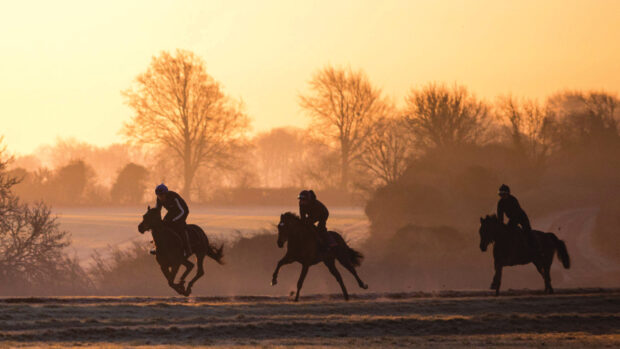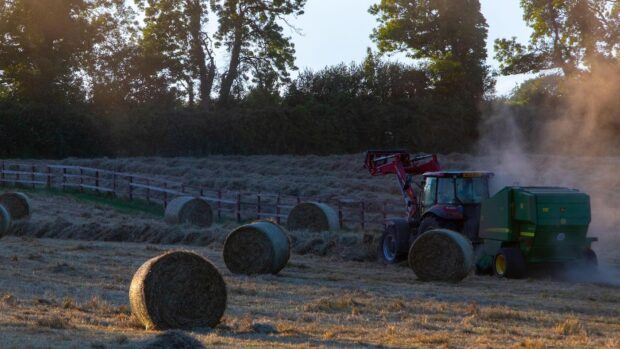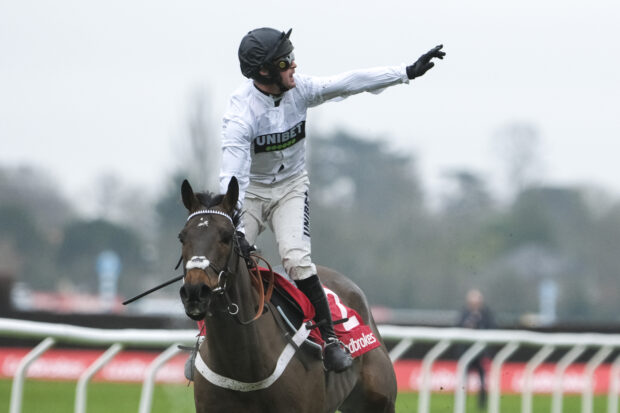Horse welfare and marginal gains – one the foundation on which equestrian sport is built, the other the “one percent” difference between winning and losing. Finding a way to improve both is the art of successful horsemanship. Being able to quantify that adds a scientific layer to that art.
Joint licence-holders Daniel and Claire Kübler opened up about their scientific approach to training racehorses to shine a light on how applying evidence-based practices benefit both horse welfare and results, during their “Science of Winning” event at their Upper Lambourn base (14 May).
“I think you have to have horsemanship as the foundation for everything,” said Daniel, who delivers guest lectures at the Royal Agricultural University in genetics and exercise physiology. “What science does is it adds that layer on top of deeper analysis and gives you further insight into the horsemanship side. You can’t do the one without the other, really.”
The Küblers use bio-banding, more commonly associated with footballers, which groups young athletes by maturity rather than age.
The two-year-old arrivals have their knees x-rayed and the vets and trainers look at the length of the cannon bone, whether the growth plates are open or closed, and bone quality. This provides a piece of the puzzle when deciding how to train that individual horse. For example, whether to back off and give him time to grow or to crack on, and what biomechanics to be aware of when he is in training.
“Just because a horse is born in January doesn’t mean he is more mature than one born in May,” said Daniel.
The benefits mean they know they are not pushing horses at times when they are going through a growth spurt, or risking damaging growth plates, both central to welfare and performance.
There is the other added potential of spotting the next equine Harry Kane – the England footballer rejected by Arsenal as a child and now one of the world’s best strikers – who “just need time”.
Their horses also undergo genetic testing to help build that picture. They are tested for “speed gene” type – the myostatin gene, which controls muscle development. The three underlying myostatin gene types correlate to differences in muscle development, including rate of growth, and have been linked to optimum race distance for a horse.
“It gives you a good indication of what trip the horse wants, helps owners to be informed and involved in that process of how we’re going to campaign a horse,” said Claire, who has a master’s in physiology from Cambridge University. “We’re a big believer in if someone is new to racing, that we help them understand the whole process, we want them to question and find out more.”
On the day-to-day management, the tack used, how and when horses are fed and the designs of the stable barns are all underpinned by applied scientific studies. Vets will see each horse trot up once a week and every horse has his airway scoped before a race.
They also use a horse fitness tracking system, Equinity, which is also used in eventing, and measures speed, stride length, strides per second, heart rate and acceleration.
The pair stressed how “crucial” their team of staff is and how feedback from riders dovetails with the data Equinity measures to build a fuller picture of performance. Equally, they have found that the data is helpful in training their staff.
“It’s creating a continual development situation,” said Daniel. “It’s also great for giving positive feedback. We can go back and look at a set of times and say, ‘This is perfect.’”
Claire added: “The people in your team are everything. I think anyone in life needs to realise that their contribution matters and makes a difference. Having that quality team working together is just so valuable, irrespective of what business you are, but particularly when you’re working with horses.”
The pair spoke of how important their reputation for consistently producing sound horses is for animal welfare and as a business.
Daniel explained that it means those horses that do not make the grade are able to continue their racing careers elsewhere – potentially over jumps or abroad, with owners having a return on their investment potentially to put into another horse.
He added that for those leaving racing, it means they can “in good confidence” sell them as riding horses with an evidence-based history informing what they may be suited to in future.
“Every single person who works in this yard, everyone who ever worked in racing, started out as a person who loved horses and the thing that they care most about is the horses,” said Daniel. “You can’t get good results from horses if they’re not healthy. So the first port of call is ensuring that your horse is healthy to compete. So we build on that foundation.”
The pair has three horses targeted at Royal Ascot this year, all affordable in the context. Don’t Tell Claire and Percy’s Lad, who were bought for £15,000 and 30,000gns as respective yearlings, and Outgate, whose sire Oustrip had a covering fee of £5,000.
“We have a very scientifically based programme, but most people are doing something similar, even if they’re not able to pin down exactly why they’re doing it,” said Daniel. “It’s a process they’ve learnt by trial and error that has been handed down from generation to generation. I think all that we’ve done is we’ve taken a look at that and what science is out there that proves that this works to make the process as safe and as efficient as possible, and what we can do to reduce injuries as far as possible.
“Then by reducing the minor injury, you hopefully have less major injuries. Ultimately the goal is no fatalities, no serious injuries and horses that enjoy it and have a long career. And if they don’t have a career in racing, can have a career doing something else.”
You might also be interested in:

Subscribe to Horse & Hound magazine today – and enjoy unlimited website access all year round

Riding by numbers: how technology and analytics are giving riders the edge

Tech advances to benefit equine welfare and traceability

‘Immense benefit to horses, riders and the sport’: equine vision study leads to widespread fence colour changes
Horse & Hound magazine, out every Thursday, is packed with all the latest news and reports, as well as interviews, specials, nostalgia, vet and training advice. Find how you can enjoy the magazine delivered to your door every week, plus options to upgrade your subscription to access our online service that brings you breaking news and reports as well as other benefits.





